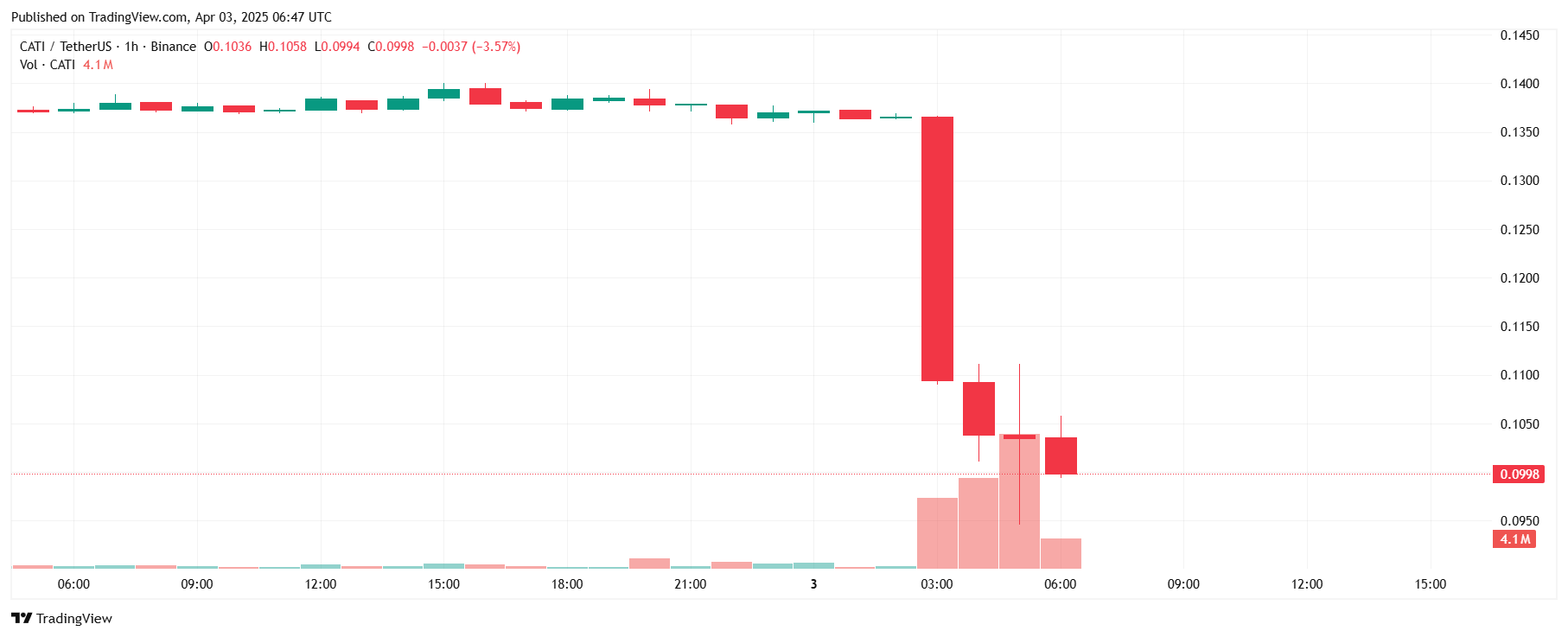
$ETH
ETH/USDT Market Analysis | Short-Term Recovery or Just a Bounce?
ETH has shown a notable recovery, currently priced at $1,598.74, up +3.84% in the past 24 hours after dipping to a low of $1,412.00. Let’s break down what’s going on and where this could be headed.
Technical Breakdown (1H Timeframe)
MACD: The MACD line is rising and attempting a bullish crossover, with the histogram flipping green. This is a potential early sign of short-term momentum returning.
KDJ: %K is at 64.71, crossing above %D and %J. Momentum appears to be turning positive, but volatility still lingers.
EMA: Price is currently above the 5, 10, and 20-period EMAs, a sign of bullish short-term structure recovery.
Volume: Volume has picked up slightly, supporting the current move, but not dramatically enough to confirm a strong breakout yet.
SAR: Parabolic SAR dots are below the price, suggesting a shift into bullish territory.
Key Levels to Watch
Support: $1,542 and $1,500 remain critical for maintaining any bullish bias.
Resistance: $1,625 and $1,655 could act as ceilings if ETH continues upward.
Future Outlook (Multi-Timeframe View)
4H Chart Outlook
On the 4-hour chart, ETH still looks oversold, but indicators like MACD and KDJ are starting to flatten. If it can hold above $1,580 and retest $1,625 with volume, we might see momentum shift more clearly to the upside.
Daily Chart Macro View
The daily chart suggests ETH is still in a downtrend channel. Any real reversal would require a break and hold above $1,700+. Otherwise, we could be looking at another lower high forming soon.
Crypto lawyer sues US DHS to uncover Satoshi Nakamoto’s true identity
Crypto attorney James Murphy, also known on X as MetaLawMan, just filed a lawsuit against the U.S. Department of Homeland Security in Washington, D.C., demanding the release of information that could expose the true identity of Satoshi Nakamoto, the unknown figure behind Bitcoin, according to a report by Crypto In America.
James filed the case in D.C. District Court with the help of Brian Field, a former Assistant U.S. Attorney who now focuses on Freedom of Information Act cases. The target is a 2019 public statement made by Rana Saoud, a DHS Special Agent, who claimed during a conference that the U.S. government had already figured out who created Bitcoin.
Rana said the creator wasn’t one person but four individuals, and claimed they were all interviewed by DHS agents in California, where they explained what Bitcoin was and why they made it.
James wants the government to release the identities of those four people. He believes if the U.S. has that kind of information, it shouldn’t be kept secret.
“If the government does indeed have this information, as the DHS Special Agent has claimed, it should not be withheld from the public,” James reportedly said in a statement to Crypto In America.
James pointed out that Bitcoin’s global impact makes this information a public issue, not just a government secret. The lawsuit zeroes in on that 2019 DHS presentation. Rana’s exact words from the event are referenced in the case.
She claimed the agency had both identified and located the creators of Bitcoin, had interviewed them in California, and had heard directly from them about the development and reasons behind it. Despite that claim, DHS has never publicly confirmed those interviews or revealed any of the names.
James says he’s hoping for cooperation under the current Trump administration, which promised more openness from federal agencies. He’s appealing to DHS Secretary Kristi Noem, saying she could choose to hand over the information now, without dragging the case through a long court process.
“My hope is that Secretary Noem will embrace transparency in this instance and share this information voluntarily,” James said. “However, if she does not, we are prepared to pursue this litigation as far as necessary to solve this mystery.”
He made it clear he’s willing to go the distance to get the answer. James is not the first to try and uncover who Satoshi is, but this time it’s a legal fight, not just speculation or online theories.
Some in the crypto community have supported the effort, while others believe finding out who Satoshi is could destroy the appeal of Bitcoin—which was built to be free from central control.
The community remains split. Some believe knowing Satoshi’s identity would bring clarity, while others say it could threaten Bitcoin’s decentralized status. If these four creators are real, still alive, and have access to early wallets or private keys, then a major chunk of Bitcoin could technically be controlled. That would punch a hole in everything Bitcoin was supposed to stand for.
Cryptopolitan Academy: Coming Soon - A New Way to Earn Passive Income with DeFi in 2025. Learn More
Will Nike Survive or Go Bankrupt?
The U.S. retail sector is reeling from the aftershocks of President Donald Trump's bold Liberation Day tariffs , but no brand has been hit harder than Nike. With a staggering 46% reciprocal tariff slapped on Vietnamese goods—a country that manufactures half of all Nike footwear—the iconic sportswear brand finds itself in a precarious position. Investors and consumers alike are now asking the same question: Can Nike survive this, or is it facing a financial reckoning that could spiral into bankruptcy?
Nike’s deep reliance on Vietnam is no secret. According to the company’s own 2024 annual report , 50% of its footwear and 28% of its apparel production came from the Southeast Asian nation. Vietnam's strategic advantages—low labor costs, efficient shipping routes, and a skilled workforce—have made it a manufacturing darling for global brands.
But that dependence has now turned into vulnerability. The newly imposed 46% tariff instantly inflates Nike’s production costs, destabilizing its entire supply chain overnight. Unlike competitors like Adidas, which relies on Vietnam for a smaller portion of its inventory (39% footwear and 18% apparel), Nike is disproportionately exposed to the fallout, making the blow far more severe.
At 5:06 PM New York time on April 3, Nike’s shares nosedived 6.4% in extended trading, according to Bloomberg. The decline wasn’t an anomaly—it was the tipping point after weeks of selling pressure. Nike stock had already fallen 20% in March, largely due to weak earnings and growing competition from newer brands like Hoka and On, which are chipping away at Nike’s market share with innovation-focused strategies.
This week's tariff announcement hit Nike at its weakest moment. The company’s Chief Financial Officer had already warned of continued revenue declines, and the market was listening. The reaction wasn’t isolated either—Shenzhou International, a major supplier to Nike, saw its stock plunge 18% in Hong Kong, its worst crash in over three years. The message from the market is clear: confidence is fading fast.
While it’s premature to declare Nike on the brink of bankruptcy, the threat is no longer unthinkable. The company is now trapped in a financial bind. Higher tariffs mean ballooning costs that will likely be passed on to American consumers, just as the National Retail Federation warned. But raising prices risks further alienating a consumer base already exploring fresher, trendier alternatives.
Nike may be forced to overhaul its supply chain, diversify manufacturing away from Vietnam, and cut costs aggressively. This could involve factory relocations, downsizing, or cancellation of expansion plans—all of which are expensive and time-consuming. The only thing more expensive than adapting, however, would be standing still.
Trump’s tariff move seems less about Nike specifically and more about targeting Vietnam’s massive $123.5 billion trade surplus with the U.S. Once viewed as the ideal alternative to China, Vietnam is now being portrayed as the new "bad actor" in Trump’s protectionist agenda. In his 2019 remarks, Trump accused Vietnam of being “worse than China” in terms of trade exploitation—a narrative he appears determined to revive.
Vietnam’s leadership scrambled for damage control, with Prime Minister Pham Minh Chinh even humorously offering to “golf all day” with Trump at Mar-a-Lago. Despite easing taxes on U.S. goods and approving Starlink service as goodwill gestures, the country couldn’t avoid the crosshairs. The tariffs came anyway—and with them, a looming crisis for Vietnam’s economy and for brands that bet big on its factories.
The rest of 2025 could make or break Nike. With its stock in freefall, revenues projected to drop, and costs skyrocketing, Nike will need to act fast. This could mean pivoting to domestic manufacturing, renegotiating supplier contracts, or absorbing short-term losses to preserve long-term brand equity.
Still, there are wildcards. If Trump’s tariff enforcement stalls—as former U.S. Commerce Secretary predicts—or if trade negotiations resume, Nike may find breathing room. But hoping for political reversals isn’t a business strategy. Nike needs to restructure now or risk a prolonged period of market irrelevance —or worse, financial collapse.
Nike isn’t going bankrupt tomorrow, but the storm is very real. The combination of weak earnings, intense new competition, and geopolitical exposure to Vietnam’s tariffs has turned a blue-chip stock into a risk asset overnight. If management fails to adapt swiftly, Nike could go from global icon to cautionary tale.
In the end, this isn’t just about shoes. It’s about whether one of America’s most recognized brands can navigate the new world order of trade wars, tariffs, and consumer disruption. The next few quarters will tell us if Nike is still built to last—or if it’s running out of time.
The U.S. retail sector is reeling from the aftershocks of President Donald Trump's bold Liberation Day tariffs , but no brand has been hit harder than Nike. With a staggering 46% reciprocal tariff slapped on Vietnamese goods—a country that manufactures half of all Nike footwear—the iconic sportswear brand finds itself in a precarious position. Investors and consumers alike are now asking the same question: Can Nike survive this, or is it facing a financial reckoning that could spiral into bankruptcy?
Nike’s deep reliance on Vietnam is no secret. According to the company’s own 2024 annual report , 50% of its footwear and 28% of its apparel production came from the Southeast Asian nation. Vietnam's strategic advantages—low labor costs, efficient shipping routes, and a skilled workforce—have made it a manufacturing darling for global brands.
But that dependence has now turned into vulnerability. The newly imposed 46% tariff instantly inflates Nike’s production costs, destabilizing its entire supply chain overnight. Unlike competitors like Adidas, which relies on Vietnam for a smaller portion of its inventory (39% footwear and 18% apparel), Nike is disproportionately exposed to the fallout, making the blow far more severe.
At 5:06 PM New York time on April 3, Nike’s shares nosedived 6.4% in extended trading, according to Bloomberg. The decline wasn’t an anomaly—it was the tipping point after weeks of selling pressure. Nike stock had already fallen 20% in March, largely due to weak earnings and growing competition from newer brands like Hoka and On, which are chipping away at Nike’s market share with innovation-focused strategies.
This week's tariff announcement hit Nike at its weakest moment. The company’s Chief Financial Officer had already warned of continued revenue declines, and the market was listening. The reaction wasn’t isolated either—Shenzhou International, a major supplier to Nike, saw its stock plunge 18% in Hong Kong, its worst crash in over three years. The message from the market is clear: confidence is fading fast.
While it’s premature to declare Nike on the brink of bankruptcy, the threat is no longer unthinkable. The company is now trapped in a financial bind. Higher tariffs mean ballooning costs that will likely be passed on to American consumers, just as the National Retail Federation warned. But raising prices risks further alienating a consumer base already exploring fresher, trendier alternatives.
Nike may be forced to overhaul its supply chain, diversify manufacturing away from Vietnam, and cut costs aggressively. This could involve factory relocations, downsizing, or cancellation of expansion plans—all of which are expensive and time-consuming. The only thing more expensive than adapting, however, would be standing still.
Trump’s tariff move seems less about Nike specifically and more about targeting Vietnam’s massive $123.5 billion trade surplus with the U.S. Once viewed as the ideal alternative to China, Vietnam is now being portrayed as the new "bad actor" in Trump’s protectionist agenda. In his 2019 remarks, Trump accused Vietnam of being “worse than China” in terms of trade exploitation—a narrative he appears determined to revive.
Vietnam’s leadership scrambled for damage control, with Prime Minister Pham Minh Chinh even humorously offering to “golf all day” with Trump at Mar-a-Lago. Despite easing taxes on U.S. goods and approving Starlink service as goodwill gestures, the country couldn’t avoid the crosshairs. The tariffs came anyway—and with them, a looming crisis for Vietnam’s economy and for brands that bet big on its factories.
The rest of 2025 could make or break Nike. With its stock in freefall, revenues projected to drop, and costs skyrocketing, Nike will need to act fast. This could mean pivoting to domestic manufacturing, renegotiating supplier contracts, or absorbing short-term losses to preserve long-term brand equity.
Still, there are wildcards. If Trump’s tariff enforcement stalls—as former U.S. Commerce Secretary predicts—or if trade negotiations resume, Nike may find breathing room. But hoping for political reversals isn’t a business strategy. Nike needs to restructure now or risk a prolonged period of market irrelevance —or worse, financial collapse.
Nike isn’t going bankrupt tomorrow, but the storm is very real. The combination of weak earnings, intense new competition, and geopolitical exposure to Vietnam’s tariffs has turned a blue-chip stock into a risk asset overnight. If management fails to adapt swiftly, Nike could go from global icon to cautionary tale.
In the end, this isn’t just about shoes. It’s about whether one of America’s most recognized brands can navigate the new world order of trade wars, tariffs, and consumer disruption. The next few quarters will tell us if Nike is still built to last—or if it’s running out of time.


 Lowest price
Lowest price Highest price
Highest price 











































